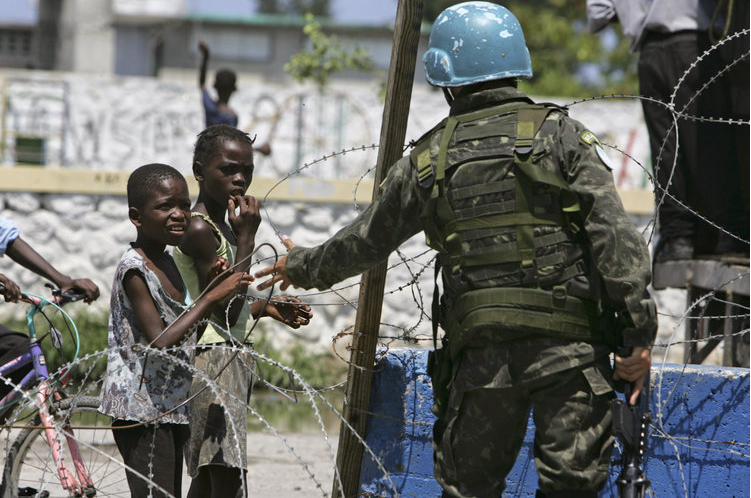The spatial footprint of international law
Contributor
Reciprocal Landscapes
Re-thinking UN peace-keeping bases as catalysts for reciprocal international justice
What do we talk about when we talk about international law? We often think of it as a virtuous project to civilize global politics and humanize violence, albeit marginal and frustrated due to its utopian character.
Yet the utopian elusiveness of international law is a perception exclusive to the Global North’s interaction based on high-level meetings and fancy summits that rarely have a lasting impact. The story becomes quite different when we shift to a Global South perspective, where the abstract mandates of ‘multilateralism’ and the ‘rules-based order’ become primarily implemented on the ground.
There, international law acquires a very real substance: lives are lost upon its inertia, while lives can be saved and tangibly improved upon its delivery. While discussion on reforming international law is vivid, international law’s—very real, not at all elusive—infrastructure in the Global South has not yet become part of the discussion. International law’s material footprint remains unchecked.
Maintaining international peace and security is at the core of international law’s raison d’ être. United Nations’ (UN) peace-keeping missions are the main vehicle to achieve this. What about the bases themselves? What about the built environment that makes international law possible? The architecture, design, and planning of these bases should become part of the agenda for achieving international justice.
*
UN bases commonly operate as secluded islands, as self-sufficient oases, often fortified behind barbed wire and trenches. Inside is everything—wells, power plants, telecommunication infrastructure, hospitals. Outside, there is often nothing.
The UN compound bears abundant untapped potential and possibilities for access by and sharing with the local population. The periphery of the base can provide this space, even in settings with relatively high threat levels. There, medical treatment and access to water, food, and electricity can be ensured. Joint projects may be developed. Education, trade, employment, and culture facilities could be designed.
*
The success of the missions housed in these bases comes with their dismantling. But the bases’ design often misses this point. Bases are single-purpose, single-use. They remain as unusable waste after the end of the mission. This is an imposition on the landscape and an open scar, a legacy of a fragile and uncertain period.
Self-governing should always be the target of peacekeeping, and this should be integrated into the mission’s architecture. Post-mission, facilities should be handed over to the local population, passed down, and potentially repurposed. The base should be a dynamic and valuable resource for the city rather than an imposition, an alien mass.
*
The construction and operation of UN bases often rely on extractive supply chains that put immense pressure on local resources and infrastructure, catalyzing the ecological consequences of protracted conflicts and playing havoc with public health. There are large carbon demands. There is an asymmetry in consumption and waste production—a UN peacekeeper produces about three times more waste than a Malian.1 And of course, there is the need for proper waste management—especially given the tragic precedent of the cholera epidemic in Haiti following the mismanagement of wastewater by a UN post-earthquake mission.2 UN bases force local communities to share scarce resources with peacekeepers, literally draining them.
The spatial footprint of peace-keeping needs to be more sustainable. Local sourcing needs to take place when profitable for the community. Lessons need to be learned from local solutions, craftsmanship, and expertise. UN bases should drive positive ecological impact, towards favorable microclimates, soil fertility, food security, and insulation from extreme weather phenomena and climate change consequences.
*
When a UN mission leaves, the community should be left more empowered and more resilient than before. Not in neo-colonial or Messianic terms. UN missions should not take place as yet another form of Western occupation or expression of Western supremacy.
The spatial reality produced by international law in peace-keeping areas should be addressed in terms of reciprocity. UN bases impose an idea of peace, safety and security, of which the local populations are not part. They feel estranged and exploited in their own space. This needs to change.
Vasiliki Poula (LSE LLM ’24) is interested in legal geography and spatial policy-making.

- L. Maertens and M. Shoshan, ‘Greening Peacekeeping: The Environmental Impact of UN Peace Operations’ (April 2018) International Peace Institute - Providing for peacekeeping No. 17, p. 6 ↩︎
- UN General Assembly, ‘New Approach to Cholera in Haiti: Report of the Secretary-General’ (3 May 2017) UN Doc. A/71/895, p. 4. ↩︎